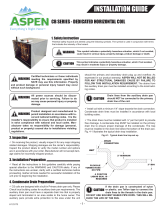
5
Quick Connect 2
This procedure can be used if there is enough room and
lineset length to connect the lineset directly to the coil and
eliminate the need for the quick connects.
1.Verifythatthereissufcientlengthoflinesettoreach
the coil. Allow for appropriate and adequate bend radius.
2.Verifythatthereissufcientroomforthetubingwhen
appropriate radii are added to the lineset.
3.Cuttheexistingquickconnectendsfromthelineset.
4.IfTXVkitandnewliquidlinearebeinginstalled,skip
to step 7.
5.Iforiginalliquidlineisbeingused,relieveallpressure
from the coil by depressing the valve on the liquid line.
Removethevalvecore.
6.Using all appropriate cautions,unbrazeand remove
the valve holder on the liquid line.
7.Connectthesuctionandliquidlinesettubes.
CAUTION:
It is recommended that a wet rag be wrapped
around the suction line in front of the close
off plate before applying heat. Failure to keep
components cool during brazing may result
in structural damage, premature equipment
failure, or possible personal injury.
IMPORTANT: To prevent internal oxidation and scaling
from occuring, braze all connections with dry nitrogen
owingthroughthejoints.
8.Braze the individual connections with dry nitrogen
flowing through the joints.
9. Wrap the refrigerant lines with pressure sensitive
neoprene or other suitable material especially where
the lines enter the opening in the sheet metal.
10. Proceed to Completing the Installation section.
Downturn
1. Determine the appropriate connection kit by referring
toTable3(page6).
2.Cutoff 2.5inches off thecoil suctionand liquid line
tubes. DO NOT swage the cut ends.
3.Connectkitpartstocoil.
CAUTION:
It is recommended that a wet rag be wrapped
around the suction line in front of the close
off plate before applying heat. Failure to keep
components cool during brazing may result
in structural damage, premature equipment
failure, or possible personal injury.
IMPORTANT: To prevent internal oxidation and scaling
from occuring, braze all connections with dry nitrogen
owingthroughthejoints.
4.Braze the individual connections with dry nitrogen
flowing through the joints.
5.Connectthesuctionandliquidlinesettubes.
6.Braze the individual connections with dry nitrogen
flowing through the joints.
7. Proceed to Completing the Installation section.
Completing the Installation
1.Checkthesystemforleaks,includingthelinesetand
the brazed joints.
NOTES
• Apply a soap and water solution on each joint or union
with a small paintbrush. If bubbling is observed, the
connection is not adequately sealed.
• When installed in the horizontal right position, it is
necessary to apply insulation to the suction tube. Without
the insulation, water management issues may arise.
2.Evacuatethesystemofmoistureandnon-condensables
topreventlowefciencyoperationordamagetothe
unit. The suggested range of evacuation is 250 - 500
microns.
3.Chargethesystemwithrefrigerant.
NOTE: The amount of refrigerant necessary with a
microchannel evaporator will typically be different
than the amount designated on the condenser’s rating
label. Use either the superheat or subcooling method
(depending on the metering device used) to properly
charge the system. Refer to the condenser unit’s
documentation to determine the amount of superheat
(typically a minimum of 5° F) or subcooling (typically
between 8° F & 12° F).
4.Installthecoilaccessdoor(ifremoved).
5. Properly dispose of all removed parts.
6.Applypowertotheunit.
7. Using a permanent marker or scribe, mark a line
lengthwise from the female coupling nut to the female
coupling body.
8.Tighten an additional wrench at (60°). Refer to the
markingonthecouplingnuttoconrmtheonewrenchat
has occurred. NOTE:Thisnalwrenchatisnecessary
to ensure the formation of the metal to metal leak-proof
seal, between the male and female couplings.
9. Proceed to Completing the Installation section.








